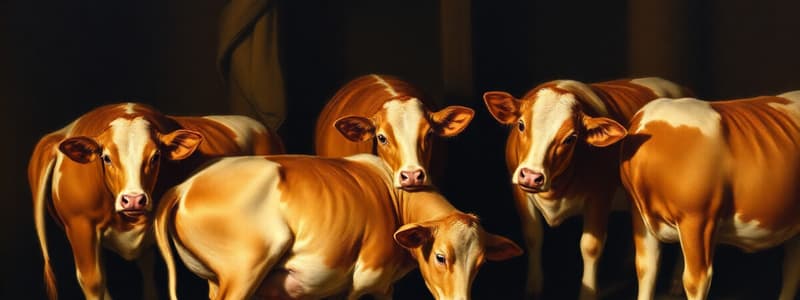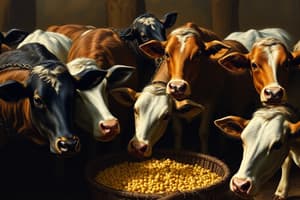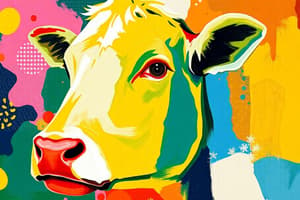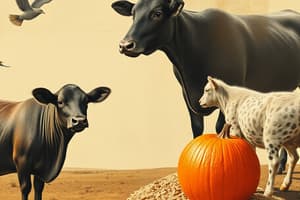Podcast
Questions and Answers
Which of the following is NOT considered a primary function of water in animal feed?
Which of the following is NOT considered a primary function of water in animal feed?
- Regulation of body temperature
- Transportation of nutrients
- Primary source of energy (correct)
- Facilitation of metabolic processes
Proteins in animal feed are primarily composed of:
Proteins in animal feed are primarily composed of:
- Fatty acids
- Mineral complexes
- Amino acids (correct)
- Glucose molecules
Which type of carbohydrate is a primary energy source for ruminants due to microbial digestion in the rumen?
Which type of carbohydrate is a primary energy source for ruminants due to microbial digestion in the rumen?
- Cellulose (correct)
- Starch
- Fructose
- Glucose
Compared to carbohydrates and proteins, fats and oils provide:
Compared to carbohydrates and proteins, fats and oils provide:
Vitamins are classified into water-soluble and fat-soluble categories. Which of the following vitamins is fat-soluble?
Vitamins are classified into water-soluble and fat-soluble categories. Which of the following vitamins is fat-soluble?
Rickets, a disease characterized by weak bones, is primarily caused by a deficiency in which mineral?
Rickets, a disease characterized by weak bones, is primarily caused by a deficiency in which mineral?
Roughages are characterized by their:
Roughages are characterized by their:
Which of the following is an example of a protein-rich concentrate used in animal feed?
Which of the following is an example of a protein-rich concentrate used in animal feed?
Urea is used as a Non-Protein Nitrogen (NPN) supplement primarily in the diets of:
Urea is used as a Non-Protein Nitrogen (NPN) supplement primarily in the diets of:
The Pearson Square method is primarily used for:
The Pearson Square method is primarily used for:
Digestibility of feed is best defined as the:
Digestibility of feed is best defined as the:
Which processing method is known to improve feed digestibility by increasing the surface area for digestive enzymes?
Which processing method is known to improve feed digestibility by increasing the surface area for digestive enzymes?
Metabolizable Energy (ME) is calculated by subtracting energy losses in feces, urine, and gas from:
Metabolizable Energy (ME) is calculated by subtracting energy losses in feces, urine, and gas from:
A nutritive ratio (NR) of 4 to 5 in animal feed is generally considered suitable for:
A nutritive ratio (NR) of 4 to 5 in animal feed is generally considered suitable for:
In non-ruminant digestion, nutrient absorption primarily occurs in the:
In non-ruminant digestion, nutrient absorption primarily occurs in the:
Which chamber of the ruminant stomach is considered the 'true stomach' and functions similarly to the stomach of non-ruminants in terms of enzymatic digestion?
Which chamber of the ruminant stomach is considered the 'true stomach' and functions similarly to the stomach of non-ruminants in terms of enzymatic digestion?
Cellulolytic bacteria in the rumen are crucial for:
Cellulolytic bacteria in the rumen are crucial for:
Volatile Fatty Acids (VFAs) produced in the rumen are primarily absorbed through the:
Volatile Fatty Acids (VFAs) produced in the rumen are primarily absorbed through the:
Methanogenic bacteria in the rumen contribute to environmental impact by producing methane. However, what is their primary role within the rumen ecosystem itself?
Methanogenic bacteria in the rumen contribute to environmental impact by producing methane. However, what is their primary role within the rumen ecosystem itself?
Consider two feed samples: Sample X with a digestibility coefficient of 0.8 and Sample Y with a digestibility coefficient of 0.6. If both samples have the same Gross Energy content, which statement is MOST accurate regarding their Net Energy contribution to an animal?
Consider two feed samples: Sample X with a digestibility coefficient of 0.8 and Sample Y with a digestibility coefficient of 0.6. If both samples have the same Gross Energy content, which statement is MOST accurate regarding their Net Energy contribution to an animal?
Study Notes
- Animal feed provides essential nutrients that support animal growth, maintenance, reproduction, and production of milk, meat, eggs, and wool.
- Key feed components are water, carbohydrates, proteins, fats, vitamins, and minerals.
Water's Role
- Water is vital for metabolic activities, digestion, temperature regulation, and waste excretion.
- Daily water requirements vary among farm animals; dairy cattle need the most.
Protein's Role
- Proteins, composed of amino acids, build tissues, produce enzymes, and support immune function.
- They are essential for muscle growth, oxygen transport via hemoglobin, metabolic regulation via hormones, and enzyme activities.
- Protein deficiency results in poor growth, reproductive issues, and weakened immunity.
- Ruminants can synthesize some amino acids in the rumen, while non-ruminants rely on dietary sources.
Carbohydrate's Role
- Carbohydrates are the main energy source for animals and come in three forms: monosaccharides, disaccharides, and polysaccharides.
- Monosaccharides include glucose and fructose.
- Disaccharides include sucrose.
- Polysaccharides include starch, cellulose, and glycogen.
- Starch is a significant energy source for animals, and ruminants depend on cellulose, which rumen microbes break down.
Fats and Oils (Lipids) Role
- Fats have more energy per gram than carbohydrates and proteins.
- Essential fatty acids like linoleic and linolenic acid maintain cell membrane integrity and hormone production.
- Fat is stored in tissues as an energy reserve.
Vitamin's Role
- Vitamins are crucial organic compounds needed in small quantities for biochemical functions.
- Water-soluble vitamins (B-complex and vitamin C) must be consumed daily.
- Fat-soluble vitamins (A, D, E, K) are stored in the liver for future use.
Mineral's Role
- Minerals include macro-elements (calcium, phosphorus, magnesium) and micro-elements/trace elements (iron, zinc, selenium).
- Mineral deficiencies lead to health problems such as rickets (calcium deficiency), anemia (iron deficiency), and white muscle disease (selenium deficiency).
Feed Types
- Animal feeds are categorized into roughages and concentrates.
- Roughages: High-fiber plant-based feeds like grasses, hay, silage, and crop residues.
- Concentrates: Low-fiber, nutrient-dense feeds are divided into protein-rich (soybean meal, fishmeal) and carbohydrate-rich (maize, wheat, sorghum) types.
Feed Supplements
- Supplements improve feed quality.
- Mineral supplements provide essential minerals lacking in soils, such as calcium and phosphorus.
- Vitamin supplements address vitamin deficiencies in animals.
- Non-Protein Nitrogen (NPN) supplements include urea, used in ruminant diets as a nitrogen source for rumen microbes.
- Growth Stimulants: Antibiotics, beta-agonists, and hormones boost growth and production.
Feed Flow Programs
- Farmers use feed flow programs to ensure consistent nutrition year-round.
- The Pearson Square Method helps create balanced rations by determining the correct proportions of protein and energy sources.
Digestibility Facts
- Digestibility measures the portion of feed absorbed by an animal's body post-digestion.
- The Digestibility Coefficient indicates how much of the feed the animal utilizes.
Factors Affecting Digestibility
- Animal species: Ruminants digest fiber more efficiently than non-ruminants.
- Feed composition: High fiber content reduces digestibility.
- Processing Methods: Grinding, pelleting, and heating enhance digestibility.
- Meal size: Large meals decrease digestion efficiency.
Methods to Improve Digestibility
- Mechanical Processing: Grinding, crushing, and rolling increase surface area for digestion, improving digestibility.
- Pelleting: Improves feed intake and digestibility, particularly in pigs and poultry.
- Heating: Cooking grains enhances their digestibility.
- Additives: Alkaline treatments break down indigestible components, improving digestibility.
Energy Value of Feed
- Gross Energy (GE): Total chemical energy in feed.
- Digestible Energy (DE): Energy available after subtracting fecal losses.
- Metabolizable Energy (ME): Energy available after subtracting energy lost in urine and gas.
- Net Energy (NE): Energy available for maintenance and production after accounting for heat loss.
Nutritive Value and Nutritive Ratio (NR)
- The nutritive ratio balances energy and protein in feed.
- Feeds with an NR of 4 to 5 are suitable for growth.
- Feeds with an NR of 7 to 8 are better for fattening.
Alimentary Canal Facts
- The alimentary canal is the passage where food moves and is digested differently in non-ruminants and ruminants.
Digestion in Non-Ruminants
- Non-ruminants (pigs, poultry) feature a simple stomach without fermentation chambers.
- Digestion involves mechanical breakdown (chewing) and chemical breakdown (enzymes/acids).
- Enzymes break down food in the stomach, small intestine, and pancreas.
- Nutrient absorption primarily happens in the small intestine.
Digestion in Ruminants
- Ruminants (cattle, sheep, goats) have a four-chambered stomach, facilitating microbial digestion.
- The rumen is the largest chamber and houses microbes that break down cellulose.
- Reticulum forms food boluses for regurgitation (cud chewing).
- Omasum absorbs water and nutrients.
- Abomasum, the "true stomach," is where enzymatic digestion occurs.
Rumen Microbes and Their Roles
- Cellulolytic Bacteria break down cellulose into volatile fatty acids (VFAs).
- Methanogenic Bacteria produce methane as a fermentation byproduct.
- Protozoa support the digestion of plant materials.
- Fungi aid in breaking down fibrous plant material.
Absorption of Nutrients in Ruminants
- VFAs produced in the rumen are the main energy source.
- Nutrients are absorbed through the rumen wall via osmosis and diffusion.
Studying That Suits You
Use AI to generate personalized quizzes and flashcards to suit your learning preferences.




